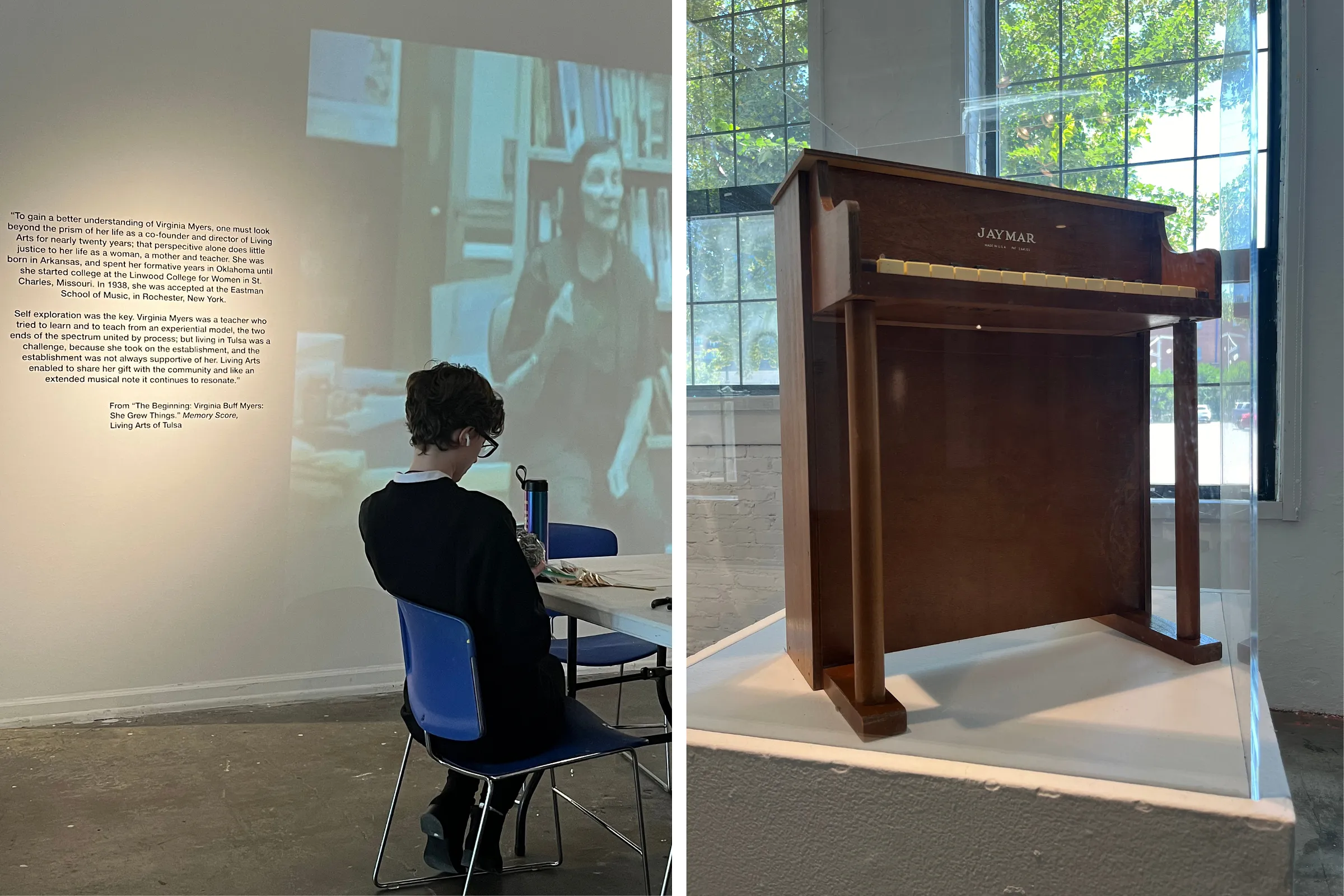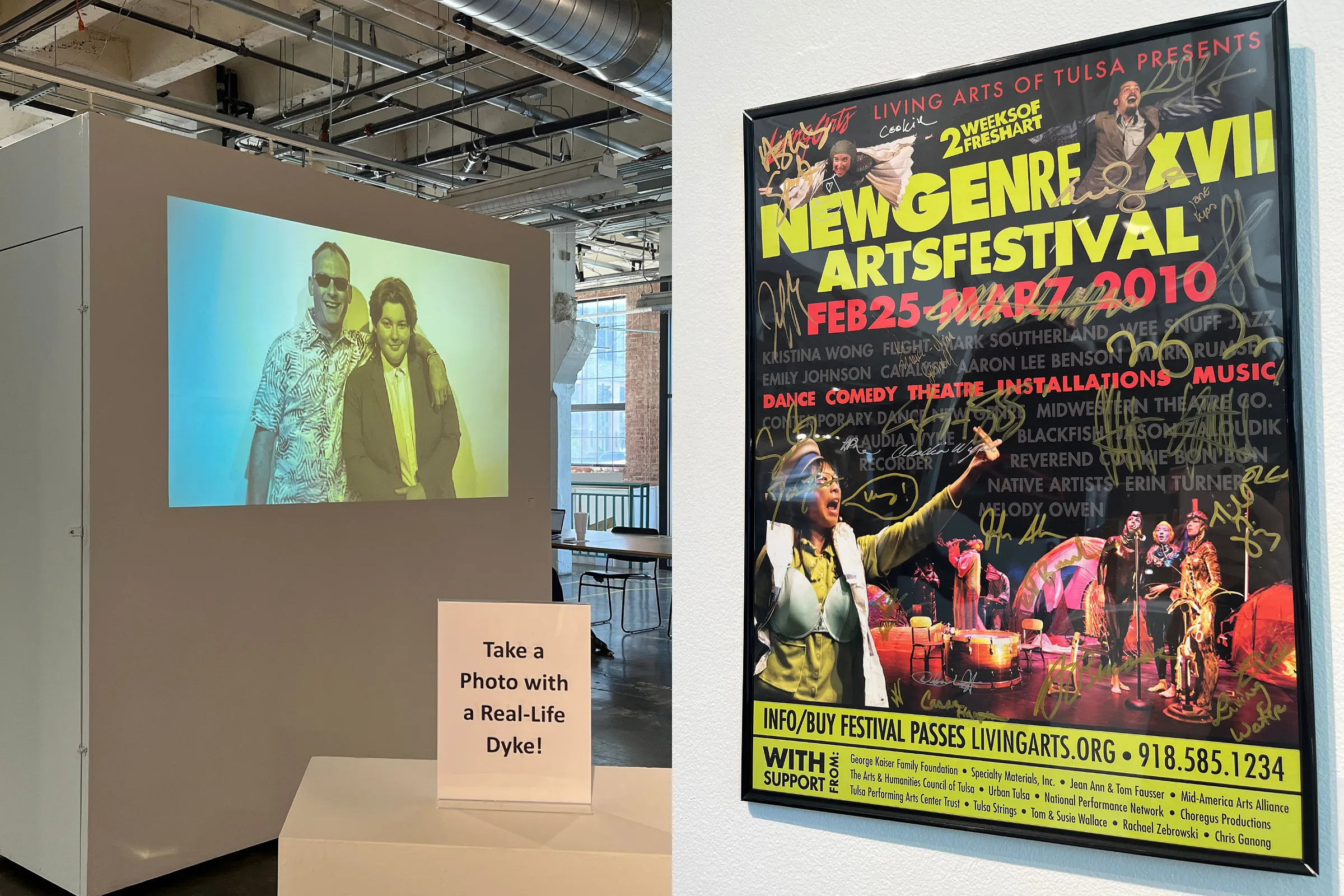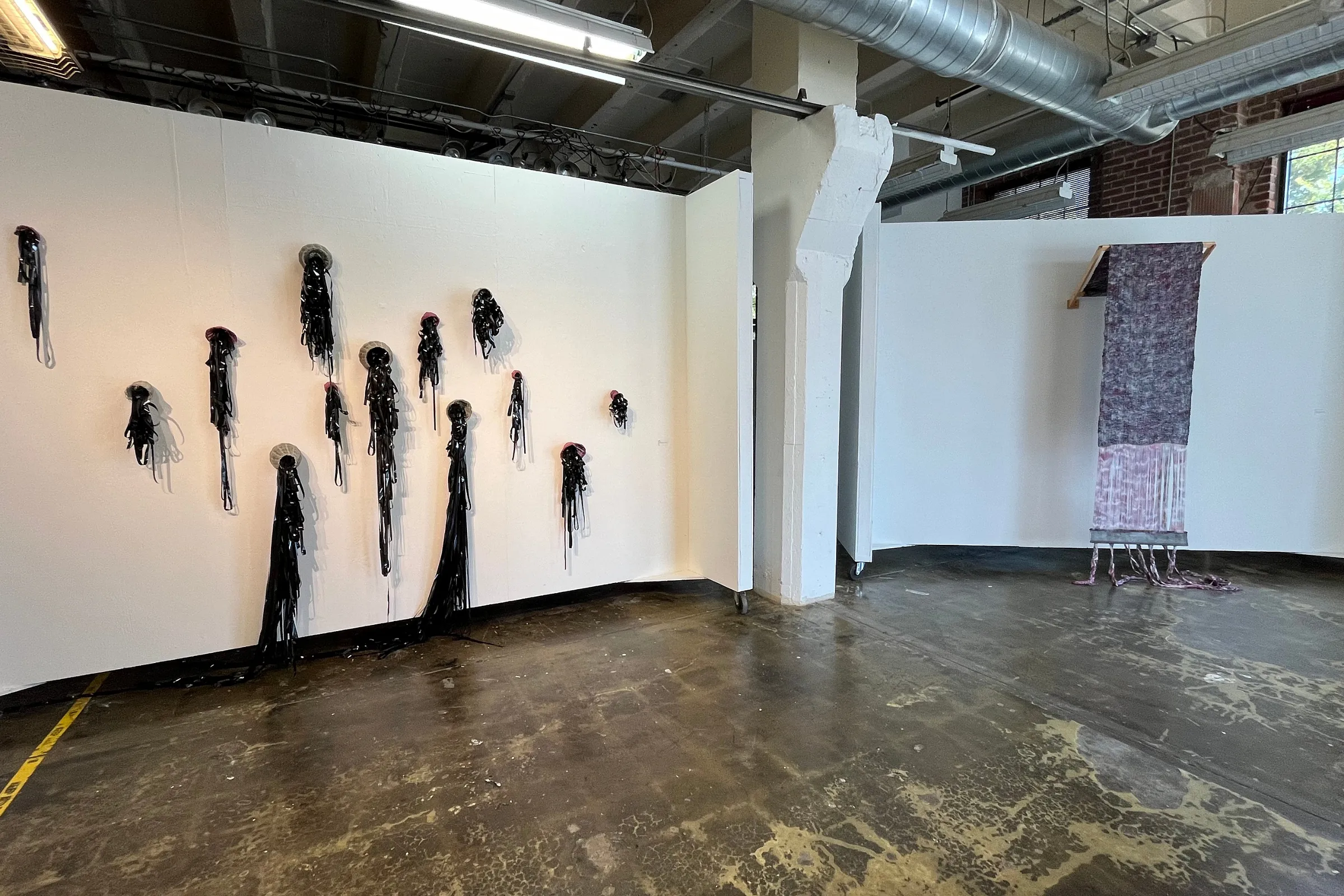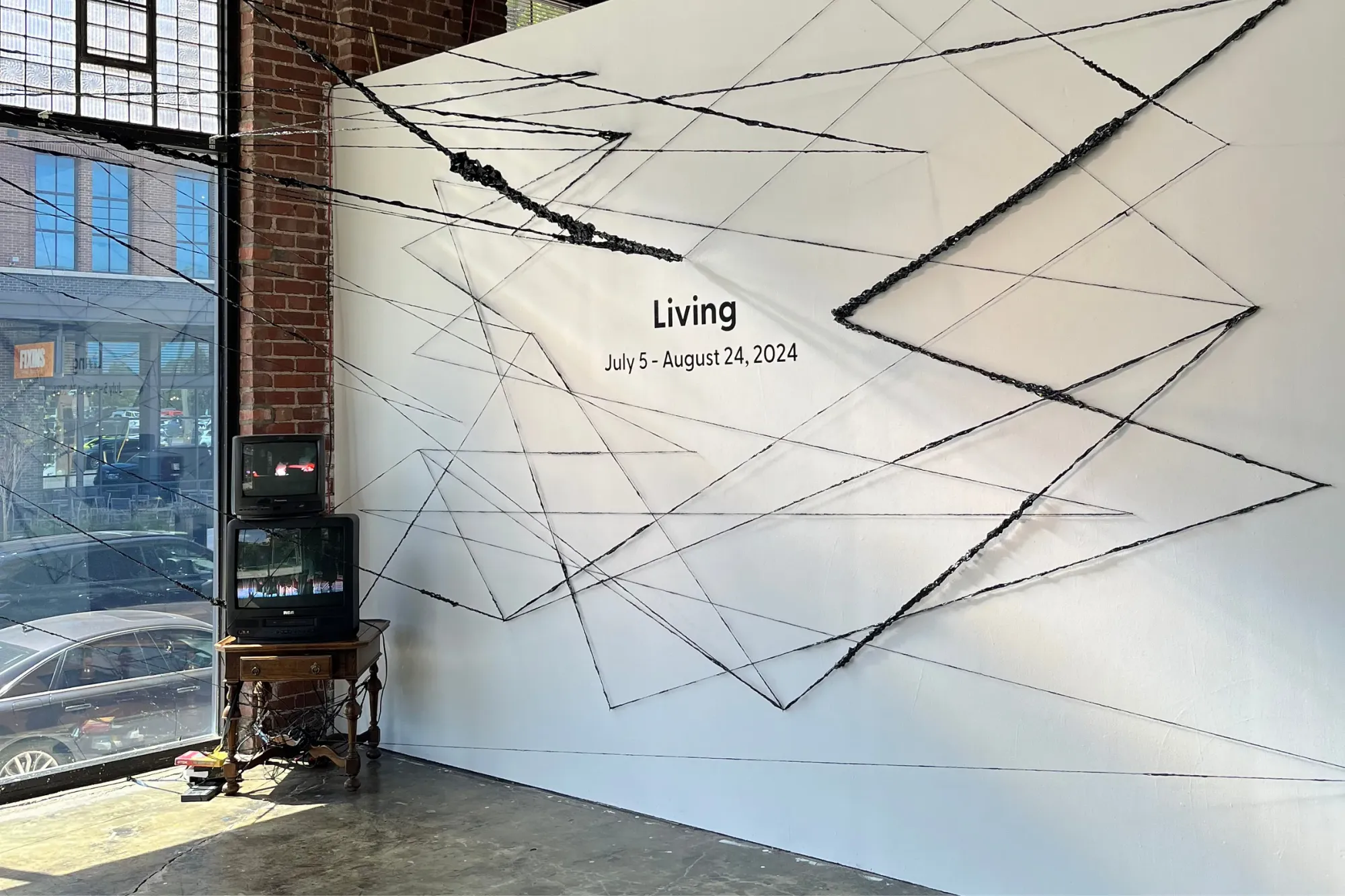“Living”
Living Arts of Tulsa
Tulsa
Through Aug. 24, 2024
I’m not sure how, growing up in the Tulsa burbs, I got so obsessed with the fringes of art. Maybe it was through my mom, a musician, who hooked pre-teen me up with the arts programming on the Bravo channel, where I first got a glimpse of people like Laurie Anderson, Nam June Paik, John Cage — the whole 20th-century lightning storm of contemporary practice.
These artists seemed worlds away from where I was living. And then I found out about Living Arts.
Going to its New Genre Festivals during my high school and college years was a revelation. I’d been to Philbrook and Gilcrease and theatre and ballet, but this was different: I never knew what I was going to experience, and that was the draw. Later, coming back to Tulsa after years in New York City, I found at Living Arts a little bit of what I’d found out there — art that stood in a thrilling, uneasy relationship with the expected, the predictable, the “normal.”
As it turns out, Tulsa always had a population of irregulars, many working in odd corners of the University of Tulsa, through the early Tulsa Artists’ Coalition, and at Living Arts, which celebrates its 55th anniversary this year. The current exhibit at the gallery — “Living,” on view through August 24 — brings some of that lineage into view.
Founded in 1969, Living Arts started as a hub for any and all contemporary art disciplines happening in Tulsa at the time — and there were a lot of them, from electronic music to sculpture to performance art. Its co-founder and visionary first director, Virginia Myers, was an Eastman School of Music-trained musician, a preternaturally gifted educator, and a single mom who owned one of the first ARP synthesizers ever made and was one of the first to perform works by modern composers like Arnold Schoenberg in Tulsa.
In her teaching, her leadership and her art practice, Myers often focused on ways to disrupt conditioned responses. “We think something is A, B, C — we know it’s that — and it’s really just L,” Steve Liggett (her successor at Living Arts) remembers her saying. Myers is rightly central to “Living”: her Fluxus-inspired experiential art pieces hang all along one wall, several videos of her loop throughout the space, and her tiny toy piano sits caddy-corner to one played here by John Cage in 1983. (Bizarre fact: September 30, 1983 was declared “John Cage Day” in Tulsa by the late Senator Jim Inhofe, then Tulsa’s mayor.)

It also felt right that, as I walked in to see this exhibit on a quiet Wednesday afternoon, Living Arts’ annual summer camp for teenagers was going on in the main gallery. From the start, this has been a place dedicated to the creative future. Local teaching artist Amber Marie Deen had several kids building installations, surrounded by works old and new by Myers, Liggett, Walt Kosty and Punto de Inflexión, a performance company whose leaders, Stephanie García and Peter Hay, have worked with Living Arts in the past. (Full disclosure: Liggett’s sculpture is part of a piece he and I are co-creating, and I’ve performed in shows at LA through the years.) In fact, all of the pieces on view in “Living” come from past or present Living Arts workers and collaborators like Jessica Davenport, Mery McNett, Sally C. Garner, José Torres-Tama and Zoey Hughes — an alum of the aforementioned summer camp and currently an MFA student, whose video-slash-performance called “Take A Photo With A Real-Life Dyke!” is a cheeky, pointed piece of next-generational work in a show that otherwise feels a little dry.
Living Arts has been spotlighting these artists on social media since “Living” opened last month, but in the exhibit itself there’s next to no information about who they are, or how they’ve been important in the organization, or in contemporary art generally in Tulsa. I know who, for example, Walt Kosty is because I’ve been following what happens at Living Arts for decades, and he was a key part of it from the beginning. But for someone without that historical memory, the tiny titles, dates, artist names and brief descriptions beside each piece would give little sense of who these players are or how these dots connect to tell this vital Tulsa story. (Cage’s piano is presented without context.) It’s beautiful to see these contributors celebrated, but a few explanatory wall texts about why they matter would have gone a long way toward making this narrative come to life. What text there is (two paragraphs about Myers) is taken from Memory Score, a wonderful history of Living Arts written by Kosty and published in 2013.

Special events during the run of “Living” — like the upcoming birthday party on August 10 — might be better occasions for engaging with it than regular gallery hours are. I didn’t feel much like jumping into Davenport’s interactive installations on my own, as fun as they looked; same with Myers’ performance prompts. Many of the vintage TVs running archival videos were powered off when I was there, as was a Torres-Tama film. And I was a little worried about a stack of archival tapes (part of a Garner installation) that were sitting on the floor in a hot beam of mid-afternoon sun.
That said, I enjoyed looking at the framed posters from New Genre Festivals past, which tell their own story about the dynamism that’s lived in Tulsa through Living Arts and the insane hard work it took to pull it all off. Past performers include Marina Abramovic, Meredith Monk, Kristina Wong and Emily Johnson, as well as local artists; festivals would take place at venues all over the city, with people running from one to the next to catch as many events as possible. (New Genre, which started in 1993, has been dormant since the pandemic.)
And the three large pieces by Garner provide a way to think conceptually about what this place does, with their VHS tape spilling out of handwoven baskets, hanging in a tight weave on a loom, or webbing across the ceiling in the west corner window. How does an ephemeral experience — a performance, a cultural phenomenon, a phase in a city’s creative life — get “captured” and “shared” and “preserved”? How does memory shape the environment we’re standing in now? What’s still undiscovered, ripe for further experimentation, in the creative history that’s brought us here?

There are many other spaces in town now doing what only Living Arts used to do. Performance art pops up regularly at art events and fashion shows. Tiny organizations like One Aux keep experimental music flowing. Site-specific installations at house shows (which LA helped pioneer here in the early ‘80s) are now a thing. Uncensored sculpture, painting and video can be seen in lots of places. With the growth of the arts scene in Tulsa over the past decade, it’s easy to forget that this was once a city that had little room (much less infrastructure) for any of that. It’s tough to say what Living Arts — then a rowdy coalition, now an Arts District anchor institution — will be in its next phase of life. But a healthy scene keeps its history close. “Living” helps remind us that change happens one person, one disrupted bit of conditioning, one all-night installation, one inspired kid, one generous wild vision at a time.
Next at Living Arts: Birthday Party, August 10






